Hispanics, Social Security, and Supplemental Security Income
Social Security Bulletin, Vol. 67, No. 2, 2007 (released February 2008)
This article uses a relatively new data source—the American Community Survey (ACS)—to document the economic and demographic characteristics of the Hispanic population in the United States. Although the article focuses on Social Security beneficiaries and Supplemental Security Income (SSI) recipients, other segments of the population are also examined. The ACS data show that the Hispanic population is significantly different from the overall population, particularly with regard to age distribution, education, and economic well-being.
The author is with the Office of Retirement Policy, Office of Policy, Social Security Administration.
Acknowledgments: Harriet Duleep, Dawn Haines, David Timmons, and David Weaver provided helpful comments and suggestions. Special thanks to Todd Williams for help in calculating standard errors for statistical testing
Contents of this publication are not copyrighted; any items may be reprinted, but citation of the Social Security Bulletin as the source is requested. The findings and conclusions presented in the Bulletin are those of the authors and do not necessarily represent the views of the Social Security Administration.
Summary
The U.S. Census Bureau reports that Hispanics are the country's largest and fastest growing minority, representing about 14.4 percent of the population in 2005 (Census Bureau 2006b). By 2050, Hispanics will account for an estimated 24.4 percent of the population—or 1 in every 4 persons in the United States (Census Bureau 2004, Table 1a). The Hispanic population tends to be younger than the overall population and currently represents a relatively small but growing fraction of the Social Security beneficiary population. The representation of Hispanics in the Supplemental Security Income (SSI) program, however, approximates that of their representation in the overall population.
This article compares the Hispanic population with the overall population along several dimensions, with a particular focus on the Social Security beneficiary and SSI recipient populations. Data are drawn mainly from the 2005 Public Use Microdata Sample of the American Community Survey (ACS PUMS), a relatively new data source with a rich set of economic and demographic variables. Fully implemented nationwide for the first time in 2005, the ACS became the largest household survey in the United States with a sample of almost 3 million addresses.
The analysis using the ACS finds that the Hispanic population is significantly different from the general population, particularly in the areas of age distribution, educational attainment, and economic well-being. Compared with the general population, the Hispanic segment is younger and is characterized by lower levels of educational attainment and a higher rate of poverty. The Hispanic Social Security beneficiary population also differs significantly from the general beneficiary population in the same areas. In contrast, the Hispanic and general SSI populations are more comparable with regard to age and economic status and differ significantly only with regard to education.
Introduction
Hispanics constitute an important, growing, and changing demographic subgroup of beneficiaries of the retirement, survivor, and disability programs under Social Security. Today, only about 6 percent of Social Security beneficiaries aged 62 or older are Hispanic, but according to projections by the Social Security Administration's MINT (Modeling Income in the Near Term) model that figure will exceed 15 percent by 2050.1 Hispanics tend to be younger than the overall population (Ramirez 2004, 4), and by 2050 they may represent an even larger fraction of younger beneficiaries (for example, those under age 62). The Hispanic beneficiary population is not only growing, but its composition is changing. As a result of immigration trends, future Hispanic beneficiary populations will probably reflect a smaller percentage of persons tracing their ancestry to the Caribbean and larger percentages with Mexican and Central American ancestry.2
Hispanics are also an important subgroup of Supplemental Security Income (SSI) recipients. SSI is a means-tested program for disabled and elderly persons who have limited income and assets. It is administered by the Social Security Administration (SSA) but is distinct from the Social Security program. Social Security is financed by payroll taxes and is paid to eligible persons who are lawfully residing in the United States. By contrast, the SSI program is financed by general funds of the U.S. Treasury and restricts payments to U.S. citizens and certain groups of qualified aliens. SSI is available to persons in the 50 states, the District of Columbia, and some U.S. territories but, importantly, not Puerto Rico. Most states provide a supplement to the federal benefit. Among persons aged 15 or older, Hispanics represent an estimated 13.0 percent of the SSI population. That figure matches the estimated percentage of Hispanics in the overall population in the same age group (13.0 percent).
The 2005 American Community Survey
Because Hispanics represent a growing subgroup of Social Security beneficiaries and a sizable fraction of SSI recipients, policymakers are showing a greater interest in their well-being.3 To provide a clearer picture of these populations, this article uses the American Community Survey (ACS), which was developed by the U.S. Census Bureau to replace data collected on the long form of the decennial census. Researchers can access detailed ACS data on income, race and ethnicity, and other economic and demographic variables through the survey's Public Use Microdata Sample (PUMS), which in 2005 contained data representing about 1.3 million households (Census Bureau 2006c).4 This study used the public-use version of the 2005 ACS PUMS.5 Future Social Security research may be able to use ACS data matched to SSA's administrative records (see Haines and Greenberg 2005, 5).6
Surveys vary, to some extent, in the wording of questions used to ascertain Hispanic origin. In the ACS, the origin of each person in the household is determined by an affirmative response to the following question: "Is this person Spanish/Hispanic/Latino?" Respondents are given five choices:
- No
- Yes, Mexican, Mexican American, Chicano
- Yes, Puerto Rican
- Yes, Cuban
- Yes, other Spanish/Hispanic/Latino
Those in the last category are asked to specify a place of origin. People in this category are from Spain, the Spanish-speaking countries of Central or South America, or the Dominican Republic or identify themselves generally as Spanish, Spanish American, Hispanic, Hispano, Latino, and so on (Census Bureau 2006a, 40). The Census Bureau notes that origin can be viewed as "heritage, nationality group, lineage, or country of birth of the person or the person's parents or ancestors" (Census Bureau 2006a, 40). Hispanics may be of any race.
The ACS includes persons who indicated that the United States was their usual place of residence at the time of the survey. This group includes the foreign-born population, which is made up of naturalized U.S. citizens, lawful permanent residents (immigrants), temporary migrants (for example, foreign students), humanitarian migrants (for example, refugees), and unauthorized migrants (people illegally present in the United States) (Census Bureau 2006a, 31).
The ACS does not ask about immigration status, and thus one cannot decompose the foreign-born population into the various component groups. For that reason, results for Hispanics presented in this article are based on the entire resident Hispanic population and are not restricted to certain groups such as citizens and lawful permanent residents. Note, however, that regardless of a survey's design, certain groups are less likely to be represented in federal surveys. For example, some analysts believe that the net undercount of unauthorized residents in the 2000 Census was much higher than that for foreign-born individuals residing in the country legally—10 percent compared with 2.5 percent (Immigration and Naturalization Service 2003).
Only persons residing in housing units in the 50 states and the District of Columbia were included in the 2005 ACS.7 Future files will also include persons in group quarters such as college dormitories, prisons, barracks, shelters, and nursing homes. In 2000, less than 3 percent of the total population resided in group quarters (Census Bureau 2001).
This article
- presents background information on the size, composition, and growth of the Hispanic population using data from a variety of sources;
- provides information from the 2005 ACS PUMS on the Hispanic Social Security beneficiary population and the overall Social Security population;
- provides information on SSI recipients; and
- discusses the findings and policy implications.
Comparisons involving the 2005 ACS PUMS data have been statistically tested using replicate weights provided by the Census Bureau. Unless otherwise indicated, all comparisons are statistically significant at the 90 percent confidence level.
Background on the Hispanic Population in the United States
This section presents an overview of the Hispanic population in the United States—where they come from, who they are, and their participation in the Social Security and Supplemental Security Income programs.
Growth of the U.S. Hispanic Population
Hispanics now represent the largest ethnic minority subgroup in the United States, and their numbers are projected to increase because of continued immigration and a birth rate that outpaces that of non-Hispanic blacks and whites.8 The U.S. Census Bureau reports that about 42.7 million Hispanics lived in the United States in 2005 (Chart 1), representing roughly 14.4 percent of the U.S. population. By 2050, Hispanics are projected to number over 100 million and account for 24.4 percent of the population (Census Bureau 2004, Table 1a).
Compared with the growth of the total U.S. population, growth of the Hispanic population was over five times greater between 1980 and 1990, over four times greater between 1990 and 2000, and almost four times greater between 2000 and 2005 (Chart 1).
Between 1980 and 1990, the Hispanic population grew by 53 percent, (Census Bureau 1993), compared with growth of only 10 percent for the total U.S. population (Census Bureau 2002). Between 1990 and 2000, the Hispanic population grew by 59 percent (Census Bureau 1993, 2006b) compared with 13 percent growth for the total U.S. population (Census Bureau 2002). Between 2000 and 2005, the Hispanic population grew by 20 percent, and the U.S. population grew by 5 percent (Census Bureau 2006b).
Growth of U.S. Hispanics and the total U.S. population
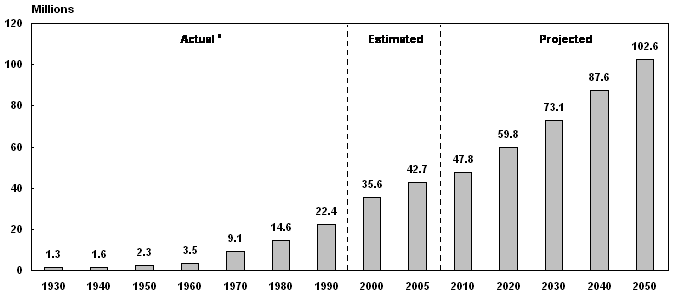
| Year | Growth (in millions) |
|---|---|
| Actual a | |
| 1930 | 1.3 |
| 1940 | 1.6 |
| 1950 | 2.3 |
| 1960 | 3.5 |
| 1970 | 9.1 |
| 1980 | 14.6 |
| 1990 | 22.4 |
| Estimated | |
| 2000 | 35.6 |
| 2005 | 42.7 |
| Projected | |
| 2010 | 47.8 |
| 2020 | 59.8 |
| 2030 | 73.1 |
| 2040 | 87.6 |
| 2050 | 102.6 |

| Years | U.S. Hispanics |
Total U.S. Population |
|---|---|---|
| 1980–1990 | 53 | 10 |
| 1990–2000 | 59 | 13 |
| 2000–2005 | 20 | 5 |
Country of Origin
More than three-quarters of U.S. Hispanics report being of Central American, primarily Mexican, descent (Chart 2). According to ACS data, the population of Mexico accounted for 26.7 percent of the total population in all Spanish-speaking countries, but the percentage of Hispanics in the United States who reported Mexican origin, or descent, was 2.6 times higher (69.3 percent), as shown in Table 1.9 Also, the U.S. Hispanic population of Mexican origin (26.8 million) is about one-fourth the size of the population of Mexico (107.0 million). These statistics reflect the role that Mexico has played in shaping the Hispanic population in the United States. Furthermore, this role has grown in the past few decades. In 1970, only 56.5 percent of Hispanics reported Mexican origin (Gibson and Jung 2005), excluding the "Other Spanish" category.
Large numbers of U.S. Hispanics report Caribbean origin: those of Puerto Rican, Cuban, and Dominican descent make up some of the largest Hispanic groups in the United States. Other large Hispanic groups include those of Salvadoran, Guatemalan, and Colombian descent.
Origin of U.S. Hispanics, 2005
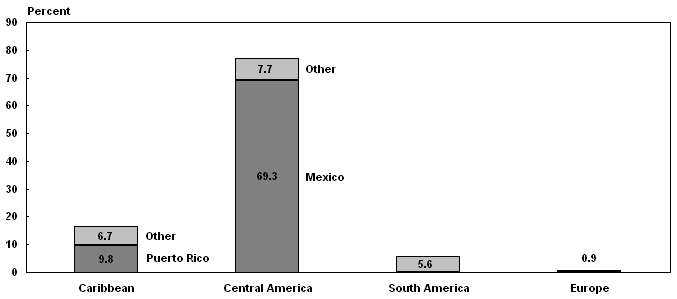
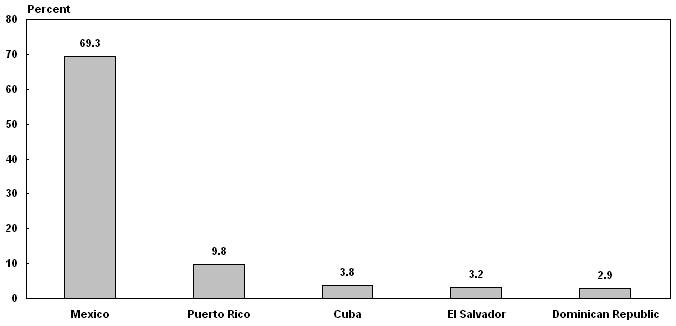
| Origin | Percent |
|---|---|
| Region of origin | |
| Caribbean | |
| Puerto Rico | 9.8 |
| Other | 6.7 |
| Central America | |
| Mexico | 69.3 |
| Other | 7.7 |
| South America | 5.6 |
| Europe | 0.9 |
| Top five countries of origin | |
| Mexico | 69.3 |
| Puerto Rico | 9.8 |
| Cuba | 3.8 |
| El Salvador | 3.2 |
| Dominican Republic | 2.9 |
| Region and country of origin |
Hispanic population in Spanish-speaking countries |
Hispanic population in the United States a | |||
|---|---|---|---|---|---|
| Number | As a percentage of total |
Number | As a percentage of total |
Ratio relative to all countries of origin combined |
|
| Total | 401,333,000 | 100.0 | 38,651,397 | 100.0 | . . . |
| Caribbean | |||||
| Cuba | 11,269,000 | 2.8 | 1,461,574 | 3.8 | 1.35 |
| Dominican Republic | 8,895,000 | 2.2 | 1,118,265 | 2.9 | 1.31 |
| Puerto Rico b | 3,955,000 | 1.0 | 3,781,317 | 9.8 | 9.93 |
| Central America | |||||
| Costa Rica | 4,327,000 | 1.1 | 108,164 | 0.3 | 0.26 |
| El Salvador | 6,881,000 | 1.7 | 1,239,640 | 3.2 | 1.87 |
| Guatemala | 12,599,000 | 3.1 | 758,898 | 2.0 | 0.63 |
| Honduras | 7,205,000 | 1.8 | 459,653 | 1.2 | 0.66 |
| Mexico | 107,029,000 | 26.7 | 26,781,547 | 69.3 | 2.60 |
| Nicaragua | 5,487,000 | 1.4 | 281,167 | 0.7 | 0.53 |
| Panama | 3,232,000 | 0.8 | 136,375 | 0.4 | 0.44 |
| South America | |||||
| Argentina | 38,747,000 | 9.7 | 185,678 | 0.5 | 0.05 |
| Bolivia | 9,182,000 | 2.3 | 65,582 | 0.2 | 0.07 |
| Chile | 16,295,000 | 4.1 | 102,911 | 0.3 | 0.07 |
| Colombia | 45,600,000 | 11.4 | 730,510 | 1.9 | 0.17 |
| Ecuador | 13,228,000 | 3.3 | 436,409 | 1.1 | 0.34 |
| Paraguay | 6,158,000 | 1.5 | 15,084 | 0 | 0.03 |
| Peru | 27,968,000 | 7.0 | 412,349 | 1.1 | 0.15 |
| Uruguay | 3,463,000 | 0.9 | 50,921 | 0.1 | 0.15 |
| Venezuela | 26,749,000 | 6.7 | 164,903 | 0.4 | 0.06 |
| Europe | |||||
| Spain | 43,064,000 | 10.7 | 360,450 | 0.9 | 0.09 |
| SOURCES: Data on the Hispanic population in Spanish-speaking countries are from United Nations (2005). Data on the Hispanic population in the United States are from the 2005 American Community Survey, Table B03001. | |||||
| NOTE: . . . = not applicable. | |||||
| a. Data exclude U.S. Hispanics who do not report a specific country of origin. Out of 41,870,703 Hispanics in the United States, 3,219,306 (about 8 percent of the total) could not be classified by country of origin. These data are based on a table from the Census Bureau that uses the full American Community Survey, not the American Community Survey Public Use Microdata Sample. | |||||
| b. The population count of Puerto Ricans from the American Community Survey includes only those interviewed in the United States, excluding Puerto Rico. | |||||
Characteristics of U.S. Hispanics
This section presents a snapshot of the demographic, economic, and other characteristics of the Hispanic population in the U.S. today and compares them with those of the overall U.S. population (Table 2).
| Characteristic | All U.S. Hispanics | Total U.S. population (including Hispanics) |
||
|---|---|---|---|---|
| Number | As a percentage of total |
Number | As a percentage of total |
|
| Demographic characteristics | ||||
| Total | 41,926,302 | 100.0 | 288,398,819 | 100.0 |
| Sex | ||||
| Male | 21,507,031 | 51.3 | 141,363,811 | 49.0 |
| Female | 20,419,271 | 48.7 | 147,035,008 | 51.0 |
| Age | ||||
| Under 15 | 12,356,973 | 29.5 | 60,614,922 | 21.0 |
| 15–24 | 6,897,734 | 16.5 | 38,853,331 | 13.5 |
| 25–61 | 19,938,489 | 47.6 | 146,637,237 | 50.8 |
| 62–74 | 1,831,864 | 4.4 | 25,852,442 | 9.0 |
| 75–84 | 716,964 | 1.7 | 12,479,794 | 4.3 |
| 85 or older | 184,278 | 0.4 | 3,961,093 | 1.4 |
| Marital status | ||||
| Married | 14,928,199 | 35.6 | 121,593,813 | 42.2 |
| Widowed | 987,864 | 2.4 | 13,727,274 | 4.8 |
| Divorced | 2,235,707 | 5.3 | 23,277,197 | 8.1 |
| Separated | 1,152,994 | 2.8 | 5,058,319 | 1.8 |
| Never married or younger than age 15 | 22,621,538 | 54.0 | 124,742,216 | 43.3 |
| Educational attainment of persons aged 25 or older a | ||||
| Total | 22,671,595 | 100.0 | 188,930,566 | 100.0 |
| No high school diploma | 9,188,480 | 40.5 | 29,780,738 | 15.8 |
| High school graduate only | 6,121,196 | 27.0 | 55,907,093 | 29.6 |
| Some college but no degree | 3,420,196 | 15.1 | 37,922,764 | 20.1 |
| Associate's degree | 1,157,135 | 5.1 | 13,942,268 | 7.4 |
| Bachelor's degree or higher | 2,784,588 | 12.3 | 51,377,703 | 27.2 |
| Earnings of persons aged 16 or older b | ||||
| Total | 20,710,142 | 100.0 | 156,958,710 | 100.0 |
| $1–16,628 | 8,838,310 | 42.7 | 51,538,084 | 32.8 |
| $16,629–36,952 | 7,667,731 | 37.0 | 49,617,246 | 31.6 |
| $36,953–59,124 | 2,669,334 | 12.9 | 29,485,724 | 18.8 |
| $59,125–89,999 | 1,041,185 | 5.0 | 15,616,269 | 9.9 |
| $90,000 or more | 493,582 | 2.4 | 10,701,387 | 6.8 |
| Poverty among persons aged 15 or older c | ||||
| Total | 41,650,181 | 100.0 | 287,268,896 | 100.0 |
| Below 100% | 9,402,750 | 22.6 | 38,413,266 | 13.4 |
| 100% to 124% | 3,328,123 | 8.0 | 12,732,863 | 4.4 |
| 125% to 149% | 3,087,906 | 7.4 | 12,668,023 | 4.4 |
| 150% or above | 25,831,402 | 62.0 | 223,454,744 | 77.8 |
| Disability status of persons aged 5 or older d | ||||
| Total | 37,364,167 | 100.0 | 268,086,256 | 100.0 |
| With disability | 4,063,347 | 10.9 | 39,708,398 | 14.8 |
| Without disability | 33,300,820 | 89.1 | 228,377,858 | 85.2 |
| Citizenship and nativity | ||||
| Total | 41,926,302 | 100.0 | 288,398,819 | 100.0 |
| U.S. citizenship | ||||
| U.S. citizen | 29,779,953 | 71.0 | 267,562,787 | 92.8 |
| Not U.S. citizen | 12,146,349 | 29.0 | 20,836,032 | 7.2 |
| Nativity | ||||
| U.S.-born e | 25,085,528 | 59.8 | 252,629,216 | 87.6 |
| Not U.S.-born | 16,840,774 | 40.2 | 35,769,603 | 12.4 |
| Language of persons aged 5 or older f | ||||
| Total | 37,364,167 | 100.0 | 268,086,256 | 100.0 |
| Ability to speak English | ||||
| English speaker g | 28,202,438 | 75.5 | 255,282,118 | 95.2 |
| Non-English speaker | 9,161,729 | 24.5 | 12,804,138 | 4.8 |
| Language spoken at home | ||||
| Only English | 8,080,214 | 21.6 | 216,078,959 | 80.6 |
| Other language h | 29,283,953 | 78.4 | 52,007,297 | 19.4 |
| SOURCE: 2005 American Community Survey, Public Use Microdata Sample. | ||||
| NOTE: . . . = not applicable. | ||||
| a. Educational attainment is restricted by author to persons aged 25 or older. | ||||
| b. Data exclude persons younger than age 16, who are not asked their earnings by the Census Bureau, and persons with zero or negative earnings. | ||||
| The 2005 national average wage was $36,952.54. Persons earning 45 percent of the average wage ($16,629) are low earners, and those earning 160 percent of the average wage ($59,125) are high earners. These figures and the maximum taxable earnings under Social Security ($90,000 in 2005) were used to define the earnings' cutoffs. | ||||
| See Table 3 for additional earnings data. | ||||
| c. The Census Bureau does not measure poverty status for unrelated individuals younger than age 15. | ||||
| d. The Census Bureau does not measure disability status for persons younger than age 5. | ||||
| e. U.S.-born includes persons born in the United States, those born abroad to U.S. parents, and those born in Guam, Northern Mariana Islands, Puerto Rico, and U.S. Virgin Islands according to the Census Bureau. | ||||
| f. The Census Bureau does not measure ability to speak English for persons younger than age 5. | ||||
| g. Defined here as a person who speaks only English at home or who speaks English well or very well in addition to speaking another language at home. | ||||
| h. The person speaks another language in addition to or in place of English. | ||||
Age and Marital Status. Hispanics tend to be younger than the general U.S. population. Almost 30 percent of Hispanics were under age 15 in 2005, compared with about 21 percent of the total population (Chart 3). Forty-six percent of Hispanics were under age 25, compared with 35 percent of the total population. In 2005, the median age for Hispanics was 27.2 years, compared with 36.4 years for the total population.10 In addition, about one-half of non-Hispanic whites were older than 40.11 Almost 15 percent of the total population was aged 62 or older, compared with only 6.5 percent of the Hispanic population. In part because Hispanics tend to be younger, they are less likely to be married—almost 36 percent of Hispanics were married, compared with more than 42 percent of the total population.
Characteristics of U.S. Hispanics and the total U.S. population, 2005
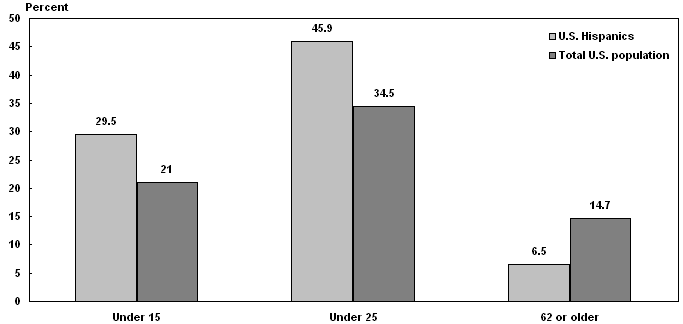
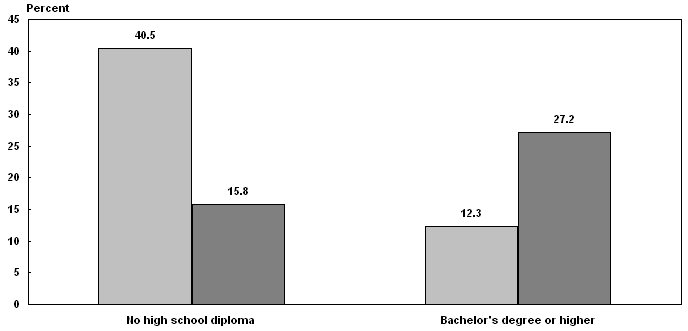
| Characteristic | U.S. Hispanics |
Total U.S. population |
|---|---|---|
| Age | ||
| Under 15 | 29.5 | 21 |
| Under 25 | 45.9 | 34.5 |
| 62 or older | 6.5 | 14.7 |
| Education | ||
| No high school diploma | 40.5 | 12.3 |
| Bachelor's degree or higher | 15.8 | 27.2 |
Education. Another difference between Hispanics and the general population is their lower level of educational attainment. About 41 percent of Hispanics aged 25 or older did not have a high school diploma in 2005, compared with 16 percent of the total population. In addition, only about 12 percent of Hispanics had a bachelor's degree or higher, compared with 27 percent of the overall population.
Economic Status. For illustrative purposes, the Office of the Chief Actuary at the Social Security Administration defines low, medium, and high earners. For 2005, a steady low earner was defined as someone earning less than $16,629 annually. The figures for medium and high earners were $36,953 and $59,125.12 These figures and the maximum taxable earnings under Social Security ($90,000 in 2005) were used to define some of the earnings cutoffs in Table 2. Approximately 43 percent of Hispanics aged 16 or older were steady low earners—earning less than $16,629 annually—compared with 33 percent of the total population (Table 2).
As shown in Table 3, average, or mean, annual earnings were also lower for Hispanics (about $25,836) than for the overall population ($37,070).13 Only in the youngest group—those aged 16–24—were annual mean earnings higher for Hispanics than for the total U.S. population. For Hispanics aged 16 or older with positive earnings, the lowest quartile earned up to $10,300, and the highest quartile earned more than $33,000. For the total population, the lowest quartile earned up to $12,000, and the highest quartile earned more than $47,000. Lower levels of education and a younger population may offer partial explanations of the relatively low earnings among Hispanics.
| All U.S. Hispanics | Total U.S. population | |
|---|---|---|
| Earnings a (dollars) | ||
| Total | 25,836 | 37,070 |
| Annual mean earnings, by age | ||
| 16–24 | 12,235 | 11,504 |
| 25–34 | 25,160 | 32,756 |
| 35–44 | 31,164 | 44,442 |
| 45–54 | 32,980 | 47,673 |
| 55–64 | 31,143 | 45,749 |
| 65 or older | 23,065 | 29,247 |
| Monthly mean earnings | 2,153 | 3,089 |
| Distribution, by earnings quartile b | ||
| First | 10,300 | 12,000 |
| Second | 20,000 | 26,900 |
| Third | 33,000 | 47,000 |
| Percentage below 100% of poverty level, by age | ||
| Under 16 | 30.0 | 19.0 |
| 16–24 | 24.5 | 20.6 |
| 25–34 | 20.2 | 13.3 |
| 35–44 | 17.5 | 10.3 |
| 45–54 | 14.1 | 8.4 |
| 55–64 | 15.9 | 8.7 |
| 65 or older | 20.3 | 9.9 |
| SOURCE: 2005 American Community Survey, Public Use Microdata Sample. | ||
| a. Data exclude persons younger than 16, who are not asked their earnings by the Census Bureau, and persons with zero or negative earnings. | ||
| b. Computation of earnings quartiles excludes persons with zero or negative earnings. | ||
Individual earnings are an important determinant of eventual retirement income because Social Security benefits, pensions, and savings are all linked to earnings, but current economic status can be more directly assessed using the poverty standard. An individual is considered poor if the family's total income is less than the appropriate poverty threshold for the family. Hispanics of all ages were 1.7 times as likely as the total population (22.6 percent versus 13.4 percent) to be living below the federal poverty level, defined as below 100 percent of the poverty level (Chart 4). Similar results were found when using measures of "near" poverty (125 percent but below 150 percent of poverty).
Poverty among U.S. Hispanics and the total U.S. population, 2005
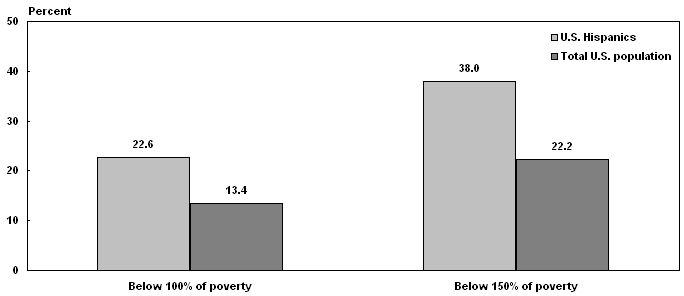
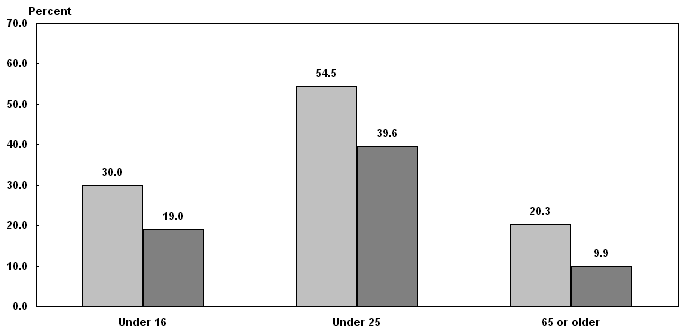
| Status/age | U.S. Hispanics | Total U.S. population |
|---|---|---|
| Poverty status | ||
| Below 100% of poverty | 22.6 | 13.4 |
| Below 150% of poverty | 38.0 | 22.2 |
| Percentage below 100 percent of poverty, by age | ||
| Under 16 | 30.0 | 19.0 |
| Under 25 | 54.5 | 39.6 |
| 65 or older | 20.3 | 9.9 |
Disability Status. According to the ACS definition of disability, Hispanics were less likely to be disabled than were individuals in the total population (10.9 percent compared to 14.8 percent), which may reflect the fact that Hispanics tend to be younger than the overall population.14
Citizenship, Nativity, and Language. The large majority of Hispanics residing in the United States (71.0 percent) are U.S. citizens.15 A majority (59.8 percent) are native born. More than three in four Hispanics are able to speak English, although close to one in five speak only English at home. Not surprisingly, these figures are different than those for the overall population, where more than four in five speak only English at home.
Hispanics Receiving Social Security and SSI
This analysis also compared selected characteristics of Hispanics receiving Social Security or SSI and compared them with other segments of the U.S. population: all U.S. Hispanics, Hispanic nonbeneficiaries, all beneficiaries, and all SSI recipients. The comparisons focus on persons aged 15 or older.16
Hispanic Beneficiaries and All Hispanics
According to the ACS, about 8 percent of all Hispanics aged 15 or older were beneficiaries of Social Security (Table 4). Hispanic Social Security beneficiaries were older relative to the overall Hispanic population (Chart 5) and more likely to be female and widowed. The incidence of poverty among the overall Hispanic population was similar to that of the subset receiving Social Security (about 20 percent). However, there are some important differences in terms of origin or descent. The beneficiary population has a larger percentage of Hispanics in the overall Caribbean group (Puerto Rico, Cuba, and Dominican Republic) and in the Spanish-descent group and smaller percentages of persons of Mexican, Central American, and South American origin.
| Characteristic | Hispanic Social Security beneficiaries |
Hispanic Supplemental Security Income recipients |
All U.S. Hispanics | |||
|---|---|---|---|---|---|---|
| Number | As a percentage of total |
Number | As a percentage of total |
Number | As a percentage of total |
|
| Demographic characteristics of persons aged 15 or older | ||||||
| Total | 2,485,175 | 100.0 | 657,247 | 100.0 | 29,569,329 | 100.0 |
| Sex | ||||||
| Male | 1,102,569 | 44.4 | 250,208 | 38.1 | 15,168,030 | 51.3 |
| Female | 1,382,606 | 55.6 | 407,039 | 61.9 | 14,401,299 | 48.7 |
| Age | ||||||
| 15–24 | 77,829 | 3.1 | 39,924 | 6.1 | 6,897,734 | 23.3 |
| 25–61 | 457,940 | 18.4 | 333,552 | 50.7 | 19,938,489 | 67.4 |
| 62–74 | 1,212,935 | 48.8 | 153,303 | 23.3 | 1,831,864 | 6.2 |
| 75–84 | 592,177 | 23.8 | 92,216 | 14.0 | 716,964 | 2.4 |
| 85 or older | 144,294 | 5.8 | 38,252 | 5.8 | 184,278 | 0.6 |
| Marital status | ||||||
| Married | 1,282,832 | 51.6 | 185,376 | 28.2 | 14,928,199 | 50.5 |
| Widowed | 561,925 | 22.6 | 118,658 | 18.1 | 987,864 | 3.3 |
| Divorced | 286,905 | 11.5 | 112,369 | 17.1 | 2,235,707 | 7.6 |
| Separated | 95,484 | 3.8 | 53,469 | 8.1 | 1,152,994 | 3.9 |
| Never married or younger than age 15 | 258,029 | 10.4 | 187,375 | 28.5 | 10,264,565 | 34.7 |
| Educational attainment of persons aged 25 or older b | ||||||
| Total | 2,407,346 | 100.0 | 617,323 | 100.0 | 22,671,595 | 100.0 |
| No high school diploma | 1,361,279 | 56.5 | 411,783 | 66.7 | 9,188,480 | 40.5 |
| High school graduate only | 554,944 | 23.1 | 124,573 | 20.2 | 6,121,196 | 27.0 |
| Some college but no degree | 254,212 | 10.6 | 49,398 | 8.0 | 3,420,196 | 15.1 |
| Associate's degree | 64,063 | 2.7 | 13,561 | 2.2 | 1,157,135 | 5.1 |
| Bachelor's degree or higher | 172,848 | 7.2 | 18,008 | 2.9 | 2,784,588 | 12.3 |
| Poverty among persons aged 15 or older c | ||||||
| Total | 2,485,175 | 100.0 | 657,247 | 100.0 | 29,569,329 | 100.0 |
| Below 100% | 504,220 | 20.3 | 283,992 | 43.2 | 5,766,509 | 19.5 |
| 100% to 124% | 240,839 | 9.7 | 81,716 | 12.4 | 2,191,804 | 7.4 |
| 125% to 149% | 205,188 | 8.3 | 51,049 | 7.8 | 2,082,998 | 7.0 |
| 150% or above | 1,534,928 | 61.8 | 240,490 | 36.6 | 19,528,018 | 66.0 |
| Disability status of persons aged 15 or older | ||||||
| Total | 2,485,175 | 100.0 | 657,247 | 100.0 | 29,569,329 | 100.0 |
| With disability | 1,176,828 | 47.4 | 611,811 | 93.1 | 3,637,695 | 12.3 |
| Without disability | 1,308,347 | 52.6 | 45,436 | 6.9 | 25,931,634 | 87.7 |
| Citizenship and nativity of persons aged 15 or older | ||||||
| Total | 2,485,175 | 100.0 | 657,247 | 100.0 | 29,569,329 | 100.0 |
| U.S. citizenship | ||||||
| U.S. citizen | 2,155,535 | 86.7 | 546,446 | 83.1 | 18,488,928 | 62.5 |
| Not U.S. citizen | 329,640 | 13.3 | 110,801 | 16.9 | 11,080,401 | 37.5 |
| Nativity | ||||||
| U.S.-born d | 1,420,806 | 57.2 | 401,275 | 61.1 | 13,905,099 | 47.0 |
| Not U.S.-born | 1,064,369 | 42.8 | 255,972 | 38.9 | 15,664,230 | 53.0 |
| Language of persons aged 15 or older | ||||||
| Ability to speak English e | ||||||
| English speaker | 1,676,925 | 67.5 | 387,454 | 59.0 | 20,964,108 | 70.9 |
| Non-English speaker | 808,250 | 32.5 | 269,793 | 41.0 | 8,605,221 | 29.1 |
| Language spoken at home f | ||||||
| Only English | 424,140 | 17.1 | 119,714 | 18.2 | 5,627,634 | 19.0 |
| Other | 2,061,035 | 82.9 | 537,533 | 81.8 | 23,941,695 | 81.0 |
| Origin of persons aged 15 or older | ||||||
| Total | 2,485,175 | 100.0 | 657,247 | 100.0 | 29,569,329 | 100.0 |
| Mexican | 1,296,088 | 52.2 | 304,271 | 46.3 | 18,288,427 | 61.8 |
| Puerto Rican | 353,615 | 14.2 | 158,268 | 24.1 | 2,720,218 | 9.2 |
| Cuban | 258,233 | 10.4 | 50,086 | 7.6 | 1,204,868 | 4.1 |
| Dominican | 58,189 | 2.3 | 35,339 | 5.4 | 823,877 | 2.8 |
| Central American | 94,992 | 3.8 | 26,629 | 4.1 | 2,372,395 | 8.0 |
| South American | 116,302 | 4.7 | 22,533 | 3.4 | 1,767,620 | 6.0 |
| Spaniard | 42,163 | 1.7 | 6,115 | 0.9 | 292,622 | 1.0 |
| Other | 265,593 | 10.7 | 54,006 | 8.2 | 2,099,302 | 7.1 |
| SOURCE: 2005 American Community Survey, Public Use Microdata Sample. | ||||||
| a. The 2005 ACS PUMS do not provide beneficiary and recipient information for persons under age 15. | ||||||
| b. Educational attainment is restricted by author to persons aged 25 or older. | ||||||
| c. The Census Bureau does not measure poverty status for unrelated individuals younger than age 15. | ||||||
| d. U.S.-born includes persons born in the United States, those born abroad to U.S. parents, and those born in Guam, Northern Mariana Islands, Puerto Rico, and U.S. Virgin Islands according to the Census Bureau. | ||||||
| e. Defined here as a person who speaks only English at home or who speaks English well or very well in addition to speaking another language at home. | ||||||
| f. The person speaks another language in addition to or in place of English. | ||||||
Characteristics of U.S. Hispanics and those receiving Social Security or Supplemental Security Income, 2005
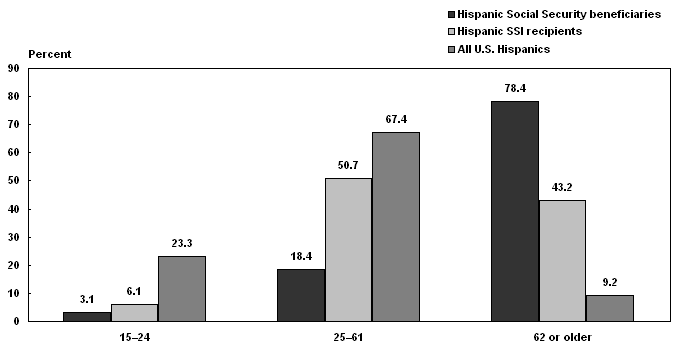
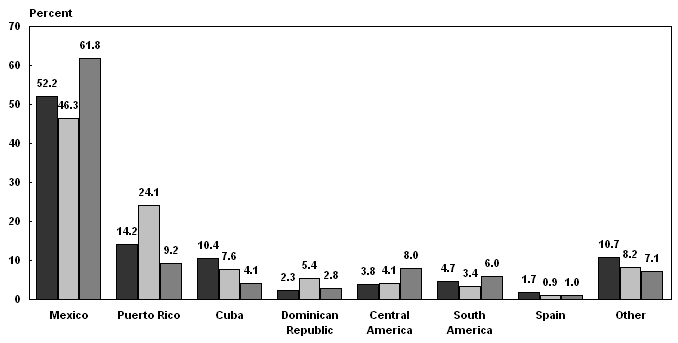
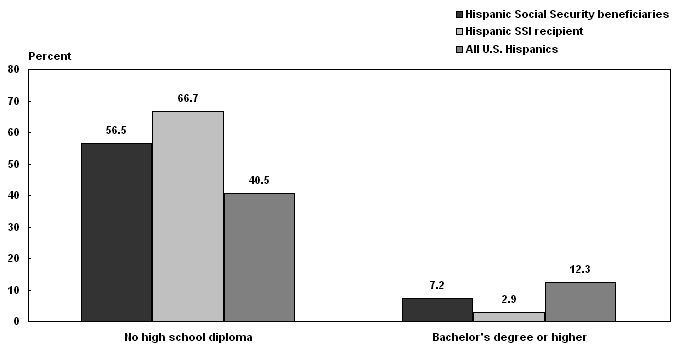
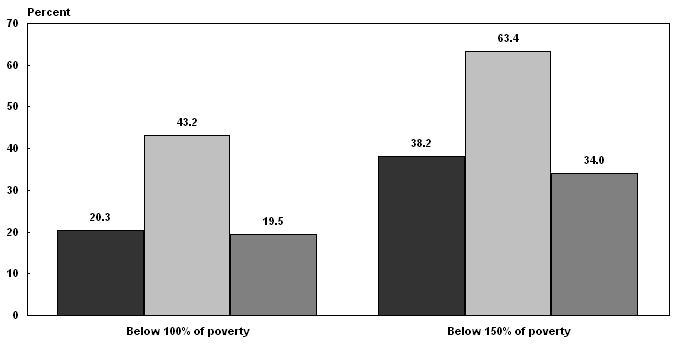
| Status | Hispanic Social Security beneficiaries |
Hispanic SSI recipients |
All U.S. Hispanics |
|---|---|---|---|
| Age | |||
| 15–24 | 3.1 | 6.1 | 23.3 |
| 25–61 | 18.4 | 50.7 | 67.4 |
| 62 or older | 78.4 | 43.2 | 9.2 |
| Origin | |||
| Mexico | 52.2 | 46.3 | 61.8 |
| Puerto Rico | 14.2 | 24.1 | 9.2 |
| Cuba | 10.4 | 7.6 | 4.1 |
| Dominican Republic | 2.3 | 5.4 | 2.8 |
| Central America | 3.8 | 4.1 | 8.0 |
| South America | 4.7 | 3.4 | 6.0 |
| Spain | 1.7 | 0.9 | 1.0 |
| Other | 10.7 | 8.2 | 7.1 |
| Education | |||
| No hich school diploma | 56.5 | 66.7 | 40.5 |
| Bachelor's degree or higher | 7.2 | 2.9 | 12.3 |
| Poverty status | |||
| Below 100% of poverty | 20.3 | 43.2 | 19.5 |
| Below 150% of poverty | 38.2 | 63.4 | 34.0 |
The vast majority of Hispanic Social Security beneficiaries (about 87 percent) were U.S. citizens. In addition, a sizable majority (about 67 percent) spoke English, and more than half (57 percent) were born in the United States.
About 2 percent of all Hispanics aged 15 or older received SSI. Compared with all Hispanics and with Hispanic Social Security beneficiaries, SSI recipients had less education and were much more likely to have low income (relative to the poverty standard). The results on poverty are not surprising, because SSI is designed to assist persons with limited income and resources. SSI recipients were also far more likely to report a disability (93.1 percent) than were all Hispanics (12.3 percent).17 A majority of SSI recipients of Hispanic origin were U.S. citizens (83.1 percent), were able to speak English (59.0 percent), and were born in the United States (61.1 percent). The relatively high level of U.S. citizenship stems from SSI restrictions on citizenship and qualified alien status.
Hispanic Beneficiaries and Nonbeneficiaries
The economic status of Hispanic Social Security beneficiaries aged 15 or older, by origin, is shown in Table 5 and compared with that of Hispanic nonbeneficiaries. For the largest group of Hispanics—those of Mexican descent—beneficiaries and nonbeneficiaries had similar levels of income (relative to the poverty threshold). Among persons of Mexican descent, the percentage below poverty was slightly lower for beneficiaries than for nonbeneficiaries (18.4 percent versus 20.8 percent), and the percentage with income above 150 percent of poverty for both groups was about 63 percent.
| Region and country of origin |
All | Below 100% of poverty |
100% to 124% | 125% to 149% | 150% or above | |||||
|---|---|---|---|---|---|---|---|---|---|---|
| Number | Percent | Number | Percent | Number | Percent | Number | Percent | Number | Percent | |
| Beneficiaries | ||||||||||
| Total | 2,485,175 | 100.0 | 504,220 | 20.3 | 240,839 | 9.7 | 205,188 | 8.3 | 1,534,928 | 61.8 |
| Mexican | 1,296,088 | 100.0 | 237,959 | 18.4 | 127,845 | 9.9 | 113,056 | 8.7 | 817,228 | 63.1 |
| Caribbean | ||||||||||
| Puerto Rican | 353,615 | 100.0 | 100,787 | 28.5 | 31,379 | 8.9 | 26,278 | 7.4 | 195,171 | 55.2 |
| Cuban | 258,233 | 100.0 | 57,367 | 22.2 | 29,816 | 11.5 | 21,353 | 8.3 | 149,697 | 58.0 |
| Dominican | 58,189 | 100.0 | 21,720 | 37.3 | 5,622 | 9.7 | 5,257 | 9.0 | 25,590 | 44.0 |
| Central American | ||||||||||
| Salvadoran | 26,003 | 100.0 | 4,082 | 15.7 | 2,246 | 8.6 | 2,701 | 10.4 | 16,974 | 65.3 |
| Guatemalan | a | a | a | a | a | a | a | a | a | a |
| Other | 68,989 | 100.0 | 12,965 | 18.8 | 7,330 | 10.6 | 3,067 | 4.4 | 45,627 | 66.1 |
| South American | ||||||||||
| Colombian | 40,197 | 100.0 | 7,202 | 17.9 | 3,076 | 7.7 | 3,225 | 8.0 | 26,694 | 66.4 |
| Ecuadorian | 21,426 | 100.0 | 3,418 | 16.0 | 791 | 3.7 | 1,965 | 9.2 | 15,252 | 71.2 |
| Peruvian | a | a | a | a | a | a | a | a | a | a |
| Other | 54,679 | 100.0 | 8,704 | 15.9 | 4,001 | 7.3 | 3,687 | 6.7 | 38,287 | 70.0 |
| European | ||||||||||
| Spaniard | 42,163 | 100.0 | 4,726 | 11.2 | 4,743 | 11.2 | 1,914 | 4.5 | 30,780 | 73.0 |
| Other Hispanic | 265,593 | 100.0 | 45,290 | 17.1 | 23,990 | 9.0 | 22,685 | 8.5 | 173,628 | 65.4 |
| Nonbeneficiaries | ||||||||||
| Total | 27,084,154 | 100.0 | 5,262,289 | 19.4 | 1,950,965 | 7.2 | 1,877,810 | 6.9 | 17,993,090 | 66.4 |
| Mexican | 16,992,339 | 100.0 | 3,538,930 | 20.8 | 1,352,760 | 8.0 | 1,321,040 | 7.8 | 10,779,609 | 63.4 |
| Caribbean | ||||||||||
| Puerto Rican | 2,366,603 | 100.0 | 510,244 | 21.6 | 125,366 | 5.3 | 98,272 | 4.2 | 1,632,721 | 69.0 |
| Cuban | 946,635 | 100.0 | 133,084 | 14.1 | 49,828 | 5.3 | 35,256 | 3.7 | 728,467 | 77.0 |
| Dominican | 765,688 | 100.0 | 180,612 | 23.6 | 55,692 | 7.3 | 50,796 | 6.6 | 478,588 | 62.5 |
| Central American | ||||||||||
| Salvadoran | 913,152 | 100.0 | 135,968 | 14.9 | 67,122 | 7.4 | 77,061 | 8.4 | 633,001 | 69.3 |
| Guatemalan | 569,385 | 100.0 | 112,321 | 19.7 | 55,927 | 9.8 | 43,515 | 7.6 | 357,622 | 62.8 |
| Other | 794,866 | 100.0 | 130,391 | 16.4 | 54,037 | 6.8 | 54,412 | 6.8 | 556,026 | 70.0 |
| South American | ||||||||||
| Colombian | 528,932 | 100.0 | 56,945 | 10.8 | 26,404 | 5.0 | 25,666 | 4.9 | 419,917 | 79.4 |
| Ecuadorian | 318,343 | 100.0 | 38,382 | 12.1 | 18,565 | 5.8 | 19,215 | 6.0 | 242,181 | 76.1 |
| Peruvian | 315,042 | 100.0 | 29,882 | 9.5 | 17,990 | 5.7 | 24,566 | 7.8 | 242,604 | 77.0 |
| Other | 489,001 | 100.0 | 60,583 | 12.4 | 20,795 | 4.3 | 18,786 | 3.8 | 388,837 | 79.5 |
| European | ||||||||||
| Spaniard | 250,459 | 100.0 | 28,340 | 11.3 | 9,869 | 3.9 | 11,408 | 4.6 | 200,842 | 80.2 |
| Other Hispanic | 1,833,709 | 100.0 | 306,607 | 16.7 | 96,610 | 5.3 | 97,817 | 5.3 | 1,332,675 | 72.7 |
| SOURCE: 2005 American Community Survey, Public Use Microdata Sample. | ||||||||||
| a. Numbers too few to list. | ||||||||||
Some groups, however, had noticeable differences between beneficiaries and nonbeneficiaries. For example, among Hispanics of Cuban origin, nonbeneficiaries had relatively high economic status: the percentage with income below 150 percent of poverty (about 23 percent) was roughly half the percentage for beneficiaries of the same origin (about 42 percent). The general pattern observed with Hispanics of Cuban descent was also observed, but to a lesser extent, among those of Puerto Rican descent: 31 percent of nonbeneficiaries had income below 150 percent of the poverty level, compared with about 45 percent of beneficiaries.
Persons of Dominican origin, whether Social Security beneficiaries or nonbeneficiaries, represent the largest proportion of Hispanics living below the federal poverty level. Among beneficiaries, more than one in three were poor, and a majority (56.0 percent) had income below 150 percent of the federal poverty level. Nonbeneficiaries were somewhat better off but still had a relatively high poverty rate (23.6 percent).
Individuals who trace their origin to Spain, regardless of benefit status, were among the most likely to have income above 150 percent of the federal poverty level. About 73 percent of beneficiaries and 80 percent of nonbeneficiaries of Spanish origin had income above this threshold.
The incidence of poverty in the Hispanic community varies by ethnic origin, as discussed above, but there is no striking pattern (Chart 6). Among the largest group of Hispanics (those of Mexican descent), beneficiaries had a lower incidence of poverty than nonbeneficiaries. For some other groups, the estimated percentages were close. This result suggests that Social Security benefit receipt is not uniformly associated with declines in economic status.
Hispanic Social Security beneficiaries and nonbeneficiaries below 100 percent of the poverty level, by region and country of origin, 2005
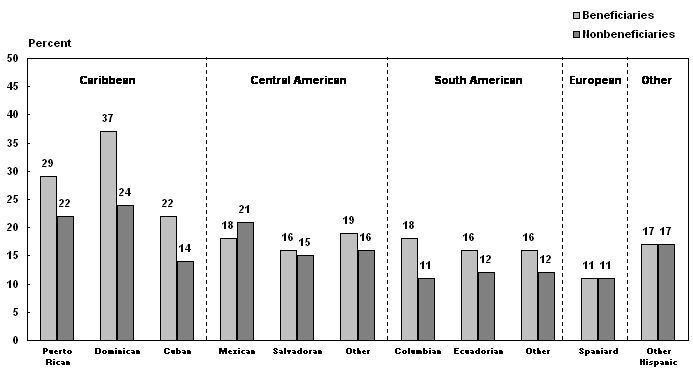
| Region and country of origin | Beneficiaries | Nonbeneficiaries |
|---|---|---|
| Caribbean | ||
| Puerto Rican | 29 | 22 |
| Dominican | 37 | 24 |
| Cuban | 22 | 14 |
| Central American | ||
| Mexico | 18 | 21 |
| Salvadorian | 16 | 15 |
| Other | 19 | 16 |
| South American | ||
| Columbian | 18 | 11 |
| Ecuadorian | 16 | 12 |
| Other | 16 | 12 |
| European | ||
| Spaniard | 11 | 11 |
| Other | ||
| Other Hispanic | 17 | 17 |
Hispanic Social Security Beneficiaries and All Beneficiaries
Hispanics aged 15 or older have lower average Social Security benefits than do their counterparts among all beneficiaries (Table 6). Their mean annual Social Security benefit in 2005 was about $8,056, compared with about $9,900 for all beneficiaries. Twenty-five percent of Hispanic beneficiaries received up to $4,900 in annual benefits. By comparison, for the overall beneficiary population, the 25th percentile cutoff occurred at $6,100.
| Benefit amount | Hispanic beneficiaries | All beneficiaries |
|---|---|---|
| Mean Social Security benefit | ||
| Annual | 8,056 | 9,879 |
| Monthly | 671 | 823 |
| Distribution, by benefit quartile | ||
| First | 4,900 | 6,100 |
| Second | 7,200 | 9,600 |
| Third | 10,800 | 13,000 |
| SOURCE: 2005 American Community Survey, Public Use Microdata Sample. | ||
Social Security benefits are based on earnings in covered employment. As noted in Table 2, Hispanics had lower relative earnings than the overall U.S. population, which will translate into lower average benefits. Note, however, that Social Security's benefit formula provides higher replacement rates (benefits as a percentage of preretirement earnings) for people with low lifetime earnings. This feature helps persons who consistently earn low wages or who have partial careers under the Social Security program and have not accrued the minimum of 40 quarters of coverage under Social Security to be eligible for retirement benefits. Thus, although benefits received by Hispanics tend to be lower than those for the overall population, they probably replace a higher percentage of their preretirement earnings.
Hispanic beneficiaries were nearly twice as likely as all beneficiaries to be living below the federal poverty level—20.3 percent versus 10.7 percent (see Chart 7 and Table 7, which presents selected characteristics of Hispanic beneficiaries and all beneficiaries). They were also 1.8 times as likely as the overall Social Security population to have income below 125 percent of the poverty level and 1.6 times as likely to have income below 150 percent of the poverty level. Recall that the relatively low economic status of Hispanics was also apparent among persons of working age (see Table 2). In other words, Hispanics do not necessarily suffer sharp drops in well-being at retirement; rather, their well-being in retirement may reflect factors that also exist during their working years.
Poverty status and education of Hispanic Social Security beneficiaries and all beneficiaries, 2005
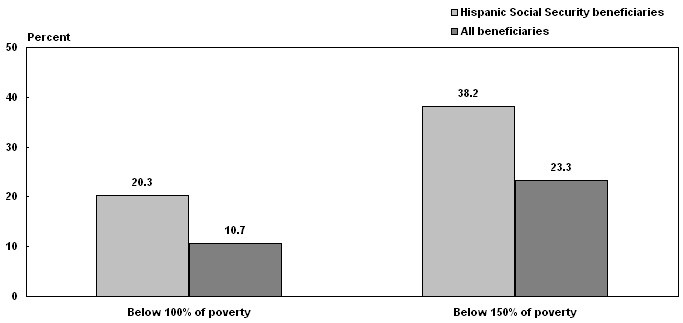
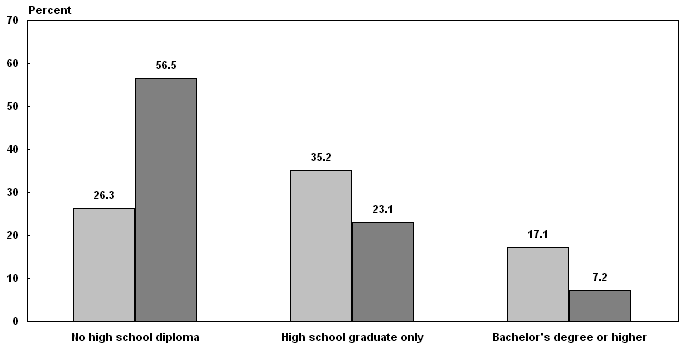
| Status | Hispanic Social Security beneficiaries |
All beneficiaries |
|---|---|---|
| Poverty status | ||
| Below 100% of poverty | 20.3 | 10.7 |
| Below 150% of poverty | 38.2 | 23.3 |
| Education | ||
| No high school diploma | 26.3 | 56.5 |
| High school graduate only | 35.2 | 23.1 |
| Bachelor's degree or higher | 17.1 | 7.2 |
| Characteristic | Hispanic beneficiaries | All beneficiaries | ||
|---|---|---|---|---|
| Number | As a percentage of total |
Number | As a percentage of total |
|
| Demographic characteristics of persons aged 15 or older | ||||
| Total | 2,485,175 | 100.0 | 40,162,673 | 100.0 |
| Sex | ||||
| Male | 1,102,569 | 44.4 | 17,610,175 | 43.8 |
| Female | 1,382,606 | 55.6 | 22,552,498 | 56.2 |
| Age | ||||
| 15–24 | 77,829 | 3.1 | 662,934 | 1.7 |
| 25–61 | 457,940 | 18.4 | 4,719,388 | 11.8 |
| 62–74 | 1,212,935 | 48.8 | 19,689,798 | 49.0 |
| 75–84 | 592,177 | 23.8 | 11,452,945 | 28.5 |
| 85 or older | 144,294 | 5.8 | 3,637,608 | 9.1 |
| Marital status | ||||
| Married | 1,282,832 | 51.6 | 22,011,219 | 54.8 |
| Widowed | 561,925 | 22.6 | 10,403,905 | 25.9 |
| Divorced | 286,905 | 11.5 | 4,184,446 | 10.4 |
| Separated | 95,484 | 3.8 | 592,560 | 1.5 |
| Never married or younger than age 15 | 258,029 | 10.4 | 2,970,543 | 7.4 |
| Educational attainment of persons aged 25 or older b | ||||
| Total | 2,407,346 | 100.0 | 39,499,739 | 100.0 |
| No high school diploma | 1,361,279 | 56.5 | 10,372,664 | 26.3 |
| High school graduate only | 554,944 | 23.1 | 13,916,488 | 35.2 |
| Some college but no degree | 254,212 | 10.6 | 6,906,004 | 17.5 |
| Associate's degree | 64,063 | 2.7 | 1,565,198 | 4.0 |
| Bachelor's degree or higher | 172,848 | 7.2 | 6,739,385 | 17.1 |
| Poverty among persons aged 15 or older c | ||||
| Total | 2,485,175 | 100.0 | 40,162,673 | 100.0 |
| Below 100% | 504,220 | 20.3 | 4,285,977 | 10.7 |
| 100% to 124% | 240,839 | 9.7 | 2,509,942 | 6.2 |
| 125% to 149% | 205,188 | 8.3 | 2,561,446 | 6.4 |
| 150% or above | 1,534,928 | 61.8 | 30,805,308 | 76.7 |
| Disability status of persons aged 15 or older | ||||
| Total | 2,485,175 | 100.0 | 40,162,673 | 100.0 |
| With disability | 1,176,828 | 47.4 | 17,499,870 | 43.6 |
| Without disability | 1,308,347 | 52.6 | 22,662,803 | 56.4 |
| Citizenship and nativity of persons aged 15 or older | ||||
| Total | 2,485,175 | 100.0 | 40,162,673 | 100.0 |
| U.S. citizenship | ||||
| U.S. citizen | 2,155,535 | 86.7 | 39,400,143 | 98.1 |
| Not U.S. citizen | 329,640 | 13.3 | 762,530 | 1.9 |
| Nativity | ||||
| U.S.-born d | 1,420,806 | 57.2 | 36,644,520 | 91.2 |
| Not U.S.-born | 1,064,369 | 42.8 | 3,518,153 | 8.8 |
| Language of persons aged 15 or older | ||||
| Total | 2,485,175 | 100.0 | 40,162,673 | 100.0 |
| Ability to speak English e | ||||
| English speaker | 1,676,925 | 67.5 | 38,782,809 | 96.6 |
| Non-English speaker | 808,250 | 32.5 | 1,379,864 | 3.4 |
| Language spoken at home | ||||
| Only English | 424,140 | 17.1 | 35,412,572 | 88.2 |
| Other language f | 2,061,035 | 82.9 | 4,750,101 | 11.8 |
| Race of persons aged 15 or older | ||||
| Total | 2,485,175 | 100.0 | 40,162,673 | 100.0 |
| White alone | 1,591,736 | 64.0 | 34,103,524 | 84.9 |
| Black or African American alone | 40,630 | 1.6 | 3,757,786 | 9.4 |
| American Indian or Alaska native | 21,285 | 0.9 | 235,432 | 0.6 |
| Asian or Pacific Islander | 8,818 | 0.4 | 906,278 | 2.3 |
| Some other race alone | 754,727 | 30.4 | 791,137 | 2.0 |
| Two or more major race groups | 67,979 | 2.7 | 368,516 | 0.9 |
| SOURCE: 2005 American Community Survey, Public Use Microdata Sample. | ||||
| a. The 2005 ACS PUMS does not provide beneficiary and recipient information for persons under age 15. | ||||
| b. Educational attainment is restricted by author to persons aged 25 or older. | ||||
| c. The Census Bureau does not measure poverty status for unrelated individuals younger than age 15. | ||||
| d. U.S.-born includes persons born in the United States, those born abroad to U.S. parents, and those born in Guam, Northern Mariana Islands, Puerto Rico, and U.S. Virgin Islands according to the Census Bureau. | ||||
| e. Defined here as a person who speaks only English at home or who speaks English well or very well in addition to speaking another language at home. | ||||
| f. The person speaks another language in addition to or in place of English. | ||||
Educational attainment is a major determinant of labor market earnings and, ultimately, retirement income. It is therefore useful to highlight the data on educational attainment from Table 7. Nearly three-fifths (56.5 percent) of Hispanic beneficiaries never completed high school, compared with slightly more than one-fourth (26.3 percent) of beneficiaries overall. Hispanic beneficiaries were less than half as likely as the overall group to have completed a bachelor's degree (7.2 percent versus 17.1 percent).
Hispanic beneficiaries tend to be younger than other beneficiaries. Three percent of Hispanic beneficiaries are in the 15–24 age range compared with 1.7 percent of all Social Security beneficiaries. Among those aged 62 or older, Hispanics had about 8 percentage points fewer older beneficiaries—78.4 percent compared with 86.6 percent.
With regard to race, about 85 percent of all Social Security beneficiaries were white alone, compared with 64.0 percent of Hispanic beneficiaries. The second largest racial group of Social Security beneficiaries (9.4 percent) was black alone. Among Hispanic Social Security beneficiaries, the second largest group was composed of those of "Some other race alone" (30.4 percent).18
Hispanic SSI Recipients and All Recipients
The study also looked at the same selected demographics of Hispanic SSI recipients and compared them with those of all SSI recipients aged 15 or older (Table 8). The two populations were similar with regard to some key variables, namely, sex, age distributions, marital status, and poverty status. For example, regardless of Hispanic status, SSI recipients had similar high rates of poverty—above 40 percent (Chart 8). The two populations differ, however, in terms of education. About 67 percent of Hispanic beneficiaries had no high school diploma, compared with 45 percent of the general SSI population. Finally, annual payments received by Hispanics were about 8 percent lower than those received by the overall SSI population—$5,944 versus $6,420 (Table 9).
| Characteristic | Hispanic recipients | All recipients | ||
|---|---|---|---|---|
| Number | As a percentage of total |
Number | As a percentage of total |
|
| Demographic characteristics of persons aged 15 or older | ||||
| Total | 657,247 | 100.0 | 5,039,182 | 100.0 |
| Sex | ||||
| Male | 250,208 | 38.1 | 2,044,069 | 40.6 |
| Female | 407,039 | 61.9 | 2,995,113 | 59.4 |
| Age | ||||
| 15–24 | 39,924 | 6.1 | 331,208 | 6.6 |
| 25–61 | 333,552 | 50.7 | 2,972,993 | 59.0 |
| 62–74 | 153,303 | 23.3 | 950,828 | 18.9 |
| 75–84 | 92,216 | 14.0 | 551,292 | 10.9 |
| 85 or older | 38,252 | 5.8 | 232,861 | 4.6 |
| Marital status | ||||
| Married | 185,376 | 28.2 | 1,363,911 | 27.1 |
| Widowed | 118,658 | 18.1 | 791,912 | 15.7 |
| Divorced | 112,369 | 17.1 | 1,023,119 | 20.3 |
| Separated | 53,469 | 8.1 | 304,374 | 6.0 |
| Never married | 187,375 | 28.5 | 1,555,866 | 30.9 |
| Educational attainment of persons aged 25 or older b | ||||
| Total | 617,323 | 100.0 | 4,707,974 | 100.0 |
| No high school diploma | 411,783 | 66.7 | 2,138,290 | 45.4 |
| High school graduate only | 124,573 | 20.2 | 1,446,977 | 30.7 |
| Some college but no degree | 49,398 | 8.0 | 640,514 | 13.6 |
| Associate's degree | 13,561 | 2.2 | 173,697 | 3.7 |
| Bachelor's degree or higher | 18,008 | 2.9 | 308,496 | 6.6 |
| Poverty among persons aged 15 or older c | ||||
| Total | 657,247 | 100.0 | 5,039,182 | 100.0 |
| Below 100% | 283,992 | 43.2 | 2,052,513 | 40.7 |
| 100% to 124% | 81,716 | 12.4 | 535,052 | 10.6 |
| 125% to 149% | 51,049 | 7.8 | 388,064 | 7.7 |
| 150% or above | 240,490 | 36.6 | 2,063,553 | 41.0 |
| Disability status of persons aged 15 or older | ||||
| Total | 657,247 | 100.0 | 5,039,182 | 100.0 |
| With disability | 611,811 | 93.1 | 4,718,101 | 93.6 |
| Without disability | 45,436 | 6.9 | 321,081 | 6.4 |
| Citizenship and nativity of persons aged 15 or older | ||||
| Total | 657,247 | 100.0 | 5,039,182 | 100.0 |
| U.S. citizenship | ||||
| U.S. citizen | 546,446 | 83.1 | 4,810,331 | 95.5 |
| Not U.S. citizen | 110,801 | 16.9 | 228,851 | 4.5 |
| Nativity | ||||
| U.S.-born d | 401,275 | 61.1 | 4,326,677 | 85.9 |
| Not U.S. -born | 255,972 | 38.9 | 712,505 | 14.1 |
| Language of persons aged 15 or older | ||||
| Total | 657,247 | 100.0 | 5,039,182 | 100.0 |
| Ability to speak English e | ||||
| English speaker | 387,454 | 59.0 | 4,482,766 | 89.0 |
| Non-English speaker | 269,793 | 41.0 | 556,416 | 11.0 |
| Language spoken at home | ||||
| Only English | 119,714 | 18.2 | 3,987,513 | 79.1 |
| Other language f | 537,533 | 81.8 | 1,051,669 | 20.9 |
| Race of persons aged 15 or older | ||||
| Total | 657,247 | 100.0 | 5,039,182 | 100.0 |
| White alone | 344,955 | 52.5 | 3,231,517 | 64.1 |
| Black or African American alone | 13,460 | 2.0 | 1,125,967 | 22.3 |
| American Indian or Alaska native | 9,084 | 1.4 | 77,774 | 1.5 |
| Asian or Pacific Islander | 2,847 | 0.4 | 228,476 | 4.5 |
| Some other race alone | 264,856 | 40.3 | 275,541 | 5.5 |
| Two or more major race groups | 22,045 | 3.4 | 99,907 | 2.0 |
| SOURCE: 2005 American Community Survey, Public Use Microdata Sample. | ||||
| a. The 2005 ACS PUMS does not provide beneficiary and recipient information for persons under age 15. | ||||
| b. Educational attainment is restricted by author to persons aged 25 or older. | ||||
| c. The Census Bureau does not measure poverty status for unrelated individuals younger than age 15. | ||||
| d. U.S.-born includes persons born in the United States, those born abroad to U.S. parents, and those born in Guam, Northern Mariana Islands, Puerto Rico, and U.S. Virgin Islands according to the Census Bureau. | ||||
| e. Defined here as a person who speaks only English at home or who speaks English well or very well in addition to speaking another language at home. | ||||
| f. The person speaks another language in addition to or in place of English. | ||||
Poverty status and education of Hispanic Supplemental Security Income recipients and all recipients aged 15 or older, 2005
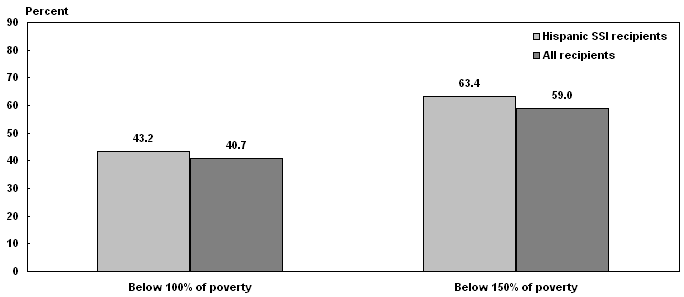
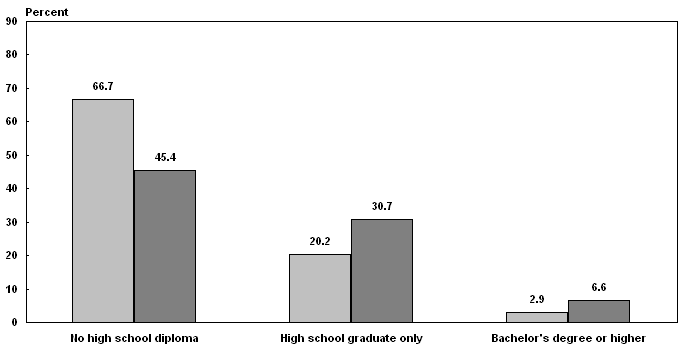
| Status | Hispanic Social Security beneficiaries |
All beneficiaries |
|---|---|---|
| Poverty status | ||
| Below 100% of poverty | 43.2 | 40.7 |
| Below 150% of poverty | 63.4 | 59.0 |
| Education | ||
| No high school diploma | 66.7 | 45.4 |
| High school graduate only | 20.2 | 30.7 |
| Bachelor's degree or higher | 2.9 | 6.6 |
| Hispanic recipients | All recipients | |
|---|---|---|
| Mean SSI payment | ||
| Annual | 5,944 | 6,420 |
| Monthly | 495 | 535 |
| Distribution, by payment quartile | ||
| First | 3,600 | 4,000 |
| Second | 6,000 | 6,400 |
| Third | 7,200 | 7,500 |
| SOURCE: 2005 American Community Survey, Public Use Microdata Sample. | ||
Policy Implications and Future Research
The demographic and economic differences among the Hispanic population underscore the importance of including more detailed and precise information about Hispanics in any analysis of the Social Security program, including analyses involving the financial status of the program and the effects of various policy options.
This article documents not only the demographic and economic characteristics of the Hispanic population in the United States but also similar characteristics of the growing and changing subgroups of Hispanic Social Security beneficiaries and SSI recipients compared with their general populations. It is important, therefore, for policymakers to consider whether the program's structure will provide adequate benefits to future beneficiary populations and to understand factors that influence economic well-being among Hispanics. For future study, it would be interesting to repeat these analyses for subgroups of the Hispanic population (such as the foreign-born population).
News reports and even scholarly studies tend to lump Hispanics into one group. Yet this article reveals a remarkable diversity within the Hispanic community, and policymakers may therefore wish to pay special attention to certain subgroups within the Hispanic community. For example, the incidence of poverty among Hispanic Social Security beneficiaries varies by ethnic origin. The findings suggest that country of origin is a strong predictor of economic well-being among U.S. Hispanics. Beneficiaries, as a rule, are not consistently worse (or better) off than nonbeneficiaries. This finding suggests that retirement (or, more specifically, Social Security benefit receipt) is not uniformly associated with declines in economic status. Quantifying the diversity across Hispanic groups may aid forecasts of the effects of various program policy options.
The analyses in this article shed some light on the relationship of U.S. Hispanics to Social Security. For instance, the relatively low earnings of Hispanics are of significance to a special aspect of the program: the Social Security benefit formula replaces a higher percentage of preretirement earnings for persons with lower lifetime earnings. Moreover, some Social Security reform proposals contain provisions that specifically target augmented benefits to low lifetime earners.
This article, however, contains a cautionary tale regarding retirement policy. The overall economic well-being of Hispanics during their working years and retirement is largely dependent on their success in the labor market, which in turn is strongly related to educational attainment. Thus, a focus only on retirement policy will not address the underlying issues associated with well-being among Hispanics.
Finally, over time the Social Security program will become increasingly important to Hispanics. As today's relatively young Hispanic population ages, more Hispanics will become eligible for the retirement, disability, and survivor benefits available under Social Security.
Notes
1. The 6 percent figure is derived from ACS tabulations in Table 7 of this article, and the 15 percent figure is based on unpublished tabulations from the MINT model (see Smith, Cashin, and Favreault [2005] for a description of MINT projection methods).
2. Population growth has varied by Hispanic group. For example, the population of Mexican descent grew by 54.4 percent between 1980 and 1990, compared with 35.4 percent and 30.0 percent for those of Puerto Rican and Cuban descent. Also, the 1980s witnessed a substantial increase in immigrants from Central America (Census Bureau 1993).
3. Data from the public-use files of the March 2001–2005 Income Supplement to the Current Population Survey indicate that the percentage of Social Security beneficiaries aged 15 or older who are Hispanic has been growing in recent years—from 5.5 percent in 2000 to 6.1 percent in 2004 (Social Security Administration 2001, 2005, Table 3.C8). Data from the same source also indicate a growing percentage of Hispanic SSI recipients.
4. See http://www.census.gov/acs/www/SBasics/index.htm for basic information about the survey, including the questionnaire and data collection procedures. Refer to http://www.census.gov
5. The PUMS was released September 11, 2006, with corrected replicate weights for statistical testing. The PUMS data are a subset of the full ACS sample (Census 2006c).
6. Matched administrative records can be used to improve information from the survey. Research indicates that some survey respondents are confused about sources of income (for example, some respondents confuse SSI income with Social Security income and vice versa). See Sears and Rupp (2003) for a fuller discussion of this and other issues related to the accuracy of survey data.
7. The population counts of Puerto Ricans in the tables in this article include only persons interviewed in the United States as part of the American Community Survey. This article excludes information on residents of Puerto Rico that is collected as part of the Puerto Rico Community Survey. That survey, which began in 2005, may be used in future work on Hispanics by SSA researchers.
8. Downs (2003) notes that Hispanic women had the highest fertility rate in 2002 among all race and origin groups.
9. The data reported here and in Table 1 illustrate patterns of origin, but they do not measure immigration status. For example, a person who reports Mexican descent may be an immigrant or a person born in the United States. Also note that Puerto Ricans are U.S. citizens.
10. Statistics on median age from the 2005 ACS are available at the American FactFinder site maintained by the Census Bureau (http://factfinder.census.gov). See Tables B01002 Median Age by Sex (Total Population) and B01002I Median Age by Sex (Hispanic or Latino).
11. See Table B01002H, Median Age by Sex (White Alone, not Hispanic or Latino) at http://factfinder.census.gov.
12. The dollar values for steady low, medium, and high earners in a given year are determined by applying factors (0.45, 1.0, and 1.6) to the year's average wage (computed for SSA program purposes). For 2005, that average wage was $36,952.94, which is close to the average wage tabulated in the ACS ($37,069.81).
13. Because the overall populations in Table 2 encompass a broad age range, some statistics (earnings and poverty) are also presented for narrower age ranges.
14. The ACS classifies individuals as disabled on the basis of whether they report sensory, physical, mental, self-care, go-outside-home, or work disabilities. Persons aged 16–64 are classified as disabled if they report at least one of these six types of disability. The go-outside-home and work disabilities questions are not used to assess persons aged 65 or older, and the questions about go-outside-home disability are not used to assess persons aged 5–15.
15. In the ACS, respondents are considered U.S. citizens if they indicated "they were born in the United States, Puerto Rico, a U.S. Island Area (such as Guam), or abroad of American (U.S. citizen) parent or parents" or indicated "they were U.S. citizens through naturalization" (Census Bureau 2006a, 31).
16. The 2005 ACS PUMS does not provide beneficiary and recipient information for persons under age 15. ACS data also do not allow for detailed analysis by beneficiary or recipient type. In addition to retirement benefits, Social Security provides disability, spouse, survivor, and child benefits. SSI provides payments to eligible blind, disabled, and aged persons.
17. The ACS definition of disability is not intended to match the definition of disability used in the Supplemental Security Income or Social Security Disability Insurance programs. Rather, its use in this article is to simply illustrate the prevalence of self-reported health problems in various populations.
18. The ACS lists White, Black or African American, American Indian or Alaska Native, Asian, Native Hawaiian or Other Pacific Islander, and "Some Other Race" race categories. Persons who select "Some Other Race" are asked to write in the race. The write in entries include general responses such as "interracial," as well as responses related to origin (for example, "Mexican").
References
Census Bureau. 1993. We, the American . . . Hispanics. Available at http://www.census.gov/apsd/wepeople/we-2r.pdf.
———. 2001. Total population in households and group quarters by sex and selected age groups, for the United States: 2000. Available at http://www.census.gov/population/cen2000/grpqtr/grpqtr01.pdf.
———. 2002. Demographic trends in the 20th century. Census 2000 Special Reports (November), Figure 1-1. Total Population: 1900-2000. Available in 2006 at http://www.census.gov/prod/2002pubs/censr-4.pdf.
———. 2004. U.S. interim projections by age, sex, race, and Hispanic origin. Available at http://www.census.gov/ipc/www/usinterimproj/.
———. 2006a. American Community Survey 2005 subject definitions. Available at http://www.census.gov/acs/www/Downloads/2005/usedata/Subject_Definitions.pdf.
———. 2006b. Annual estimates of the population by sex, race and Hispanic or Latino origin for the United States: April 1, 2000 to July 1, 2005. Available at http://www.census.gov/popest/national/asrh/NC-EST2005-srh.html.
———. 2006c. PUMS accuracy of the data (2005). Available at http://www.census.gov/acs/www/Downloads/2005/AccuracyPUMS.pdf.
Downs, Barbara. 2003. Fertility of American women, June 2002. Current Population Reports, P-20-548 (October). Also available at http://www.census.gov/prod/2003pubs/p20-548.pdf.
Gibson, Campbell, and Kay Jung. Historical census statistics on population totals by race, 1790 to 1990, and by Hispanic origin, 1970 to 1990, for the United States, regions, divisions, and states. Available at http://www.census.gov/population/www/documentation/twps0056.html.
Haines, Dawn E., and Brian Greenberg. 2005. Statistical uses of Social Security administrative data. ASA proceedings of the Joint Statistical Meetings, pp. 1138-1145. American Statistical Association (Alexandria, VA). Available at http://www.oecd.org/dataoecd/58/13/36237686.pdf.
Immigration and Naturalization Service, Office of Policy and Planning. 2003. Estimates of the unauthorized immigrant population residing in the United States: 1990 to 2000. Available at http://www.uscis.gov
Ramirez, Roberto R. 2004. We the people: Hispanics in the United States. Census 2000 Special Reports. Available at http://www.census.gov/prod/2004pubs/censr-18.pdf.
Sears, James, and Kalman Rupp. 2003. Exploring Social Security payment history matched with the Survey of Income and Program Participation. Federal Committee on Statistical Methodology Research Conference. Available at http://www.fcsm.gov/03papers/SearsRupp.pdf.
Smith, Karen E., David Cashin and Melissa Favreault. 2005. Modeling income in the near term 4: Revised projections of retirement income through 2020 for the 1931–1960 birth cohorts. Urban Institute, Washington, DC. Available at: http://www.urban.org/publications/411191.html.
Social Security Administration. 2001. Annual Statistical Supplement to the Social Security Bulletin, 2001. Washington, DC: Social Security Administration.
———. 2005. Annual Statistical Supplement to the Social Security Bulletin, 2005. Washington, DC: Social Security Administration.
United Nations. 2005. World Population Prospects, 2005. New York: United Nations, Population Division, Department of Economic and Social Affairs.